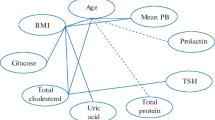Summary
Mentally retarded obese in-patients were fed by low-energy diet (4.2–4.6 MJ) for 9 months. During this period, an average of 13±4.5 kg loss of body mass occurred in men and 16±2.7 kg in women.
Anthropometric measurements were performed before starting the dietotherapy and in the ninth month. Changes of body fat could be followed well when calculated according to BMI. Less reliable results were obtained with skinfold thickness Measurements, presumably due to body deformities.
Results of clinical laboratory tests, which were carried out before starting the dietotherapy and in the fourth and seventh months, suggested that a low-energy-containing diet with balanced nutrient content and adequate protein intake did not lrnpair protein metabolism, favourably affected serum triglyceride and cholesterol levels, but resulted in an unfavourable decrease in the HDL-cholesterol content.
Zusammenfassung
Geistig behinderte, übergewichtige Patienten, die in einem geschlossenen Kollektiv lebten, verwendeten neun Monate lang eine kalorienreduzierte Kost (4,2–4,6 MJ). Während der Untersuchungsperiode war eine Körpergewichtsverminderung von 13±5,5 kg bei den Männern und 16±2,6 kg bei den Frauen zu beobachten.
Vor der Diättherapie und im neunten Monat wurden anthropometrische Untersuchungen durchgeführt. Wir konnten feststellen, daß der prozentuale Anteil des Körperfetts, nach BMI berechnet, deutlich abnahm. Anhand der Hautfaltmessungen dagegen zeigte sich diese Verminderung weniger deutlich. Das ist Wahrscheinlich auch auf die Schwierigkeiten zurückzuführen, die während der Messungen infolge körperlicher Mißbildungen auftraten.
Die klinischen Laboruntersuchungen, die vor Beginn der diätetischen Behandlung sowie im vierten und siebten Monat durchgeführt wurden, weisen darauf hin, daß eine kalorienarme Kost mit ausgeglichenem Nährstoff- bzw. Eiweißgehalt dem Eiweißstoffwechsel nicht schadet und den Triglycerid- und Cholesterinspiegel im Serum günstig beeinflußt, andererseits aber eine ungewünschte Cholesterinverminderung in der HDL-Fraktion verursacht.
Similar content being viewed by others
References
Kyle UG, Morrow SR, Hart WD (1984) Anthropometric assessment of a mentally retarded population. Nutr Rep Inter 30:271–280
Litchford MD, Wakefield LM (1985) Nutrient intake of institutionalized developmentally disabled individuals. J Am Diet Ass 85:690–692
Durnin JVGA, Rahaman MM (1967) The assessment of the amount of fat in the human body from measurements of skinfold thickness. Br J Nutr 21:681–689
Durnin JVGA, Womersley J (1974) Body fat assessed from total body density and its estimation from skinfold thickness: measurements on 481 men and women aged from 16 to 72 years. Br J Nutr 32:77–97
Womersley J, Durnin JVGA (1977) A comparison of the skinfold method with extent of “overweight” and various weight-height relationships in the assessment of obesity. Br J Nutr 38:271–284
Doumas BT, Watson WA, Biggs HG (1971) Albumin standards and the measurement of serum albumin with bromcresol green. Clin Chim Acta 31:87–96
Burstein M, Scholnick HR, Morfin R (1970) Rapid method for the isolation of lipoproteins from human serum by precipitation with polyanions. J Lipid Res 11:583–595
Lopes-Virella MF, Stone PG, Ellis S, Colwell JA (1977) Cholesterol determinations in high-density lipoproteins separated by three different methods. Clin Chem 23:882–884
Garrow JS (1978) Energy balance and obesity in man. Elsevier, North Holland, Amsterdam
Rolland-Cachera MF, Bellisle F (1986) No correlation between adiposity and food intake: Why are working class children fatter? Am J Clin Nutr 44:779–787
Report of a Joint FAO/WHO/UNU Expert Consultation. Energy and protein requirements. Techn Rep Ser 724 (1985)
Scherf J, Franklin BA, Lucas CP, Stevenson D, Rubenfire M (1986) Validity of skinfold thickness measures of formerly obese adults. Am J Clin Nutr 43:128–135
Jackson AS, Pollock ML (1978) Generalized equations for predicting body density of men. Br J Nutr 40:497–504
Jackson AS, Pollock ML, Ward J (1980) Generalized equations for predicting body density of women. Med Sci Sports 12:175–182
Rosen JC, Gross J, Loew D, Sims EAH (1985) Mood and appetite during minimal-carbohydrate and carbohydrate supplemented hypocaloric diets. Am J Clin Nutr 42:371–379
Weinsier RL, Wadden TA, Ritenbaugh C, Harrison GG, Johnson FS, Wilmore JH (1984) Recommended therapeutic guidelines for profession weight control programs. Am J Clin Nutr 40:865–872
Björvell H, Rössner S (1985) Long term treatment of severe obesity: four year follow up results of combined behavioural modification programme. Br Med J 291:379–382
Weinsier RL, Johnston MH, Doleys DM, Bacon JA (1982) Dietary management of obesity: Evaluation of the time-energy displacement diet in terms of its efficacy and nutritional adequacy for long-term weight control. Br J Nutr 47:367–379
Weinsier RL, Bacon JA, Birch R (1985) Time-calorie displacement diet for weight control: a prospective evaluation of its adequacy for maintaining normal nutritional status. In: Blackburn GL, Bray GA (eds) Management of obesity. PSG Publishing Comp Inc p 171–181
Body weight and serum cholesterol: literary overview (1985) Nutr Rev 43:43–44
Oh SY, Monaco PA (1985) Effect of dietary cholesterol and degree of fat unsaturation on plasma lipid levels, lipoprotein composition and fecal steroid excretion in normal young adult men. Am J Clin Nutr 42:399–413
Jeffery RW, Thompson PD, Wing RR (1978) Effects on weight reduction of strong monetary contracts for calorie restriction or weight loss. Behav Res Ther 16:363–369
Hulley SB, Cohen R, Widdowson G (1977) Plasma high-density lipoprotein cholesterol level. JAMA 238:2269–2271
Barta L, Czinner A, Tichy M, Bedö M (1983) A kardiovaszkuláris rizikófaktorok változása cukorbeteg gyermekek táborozása alatt. Gyermekgyógyászat 34:506–510
Author information
Authors and Affiliations
Rights and permissions
About this article
Cite this article
Antal, M., Zajkás, G., Rajháthy, B. et al. Longitudinal examinations in the course of dietotherapy of mentally retarded obese in-patients. Z Ernährungswiss 27, 101–108 (1988). https://doi.org/10.1007/BF02021649
Received:
Published:
Issue Date:
DOI: https://doi.org/10.1007/BF02021649




